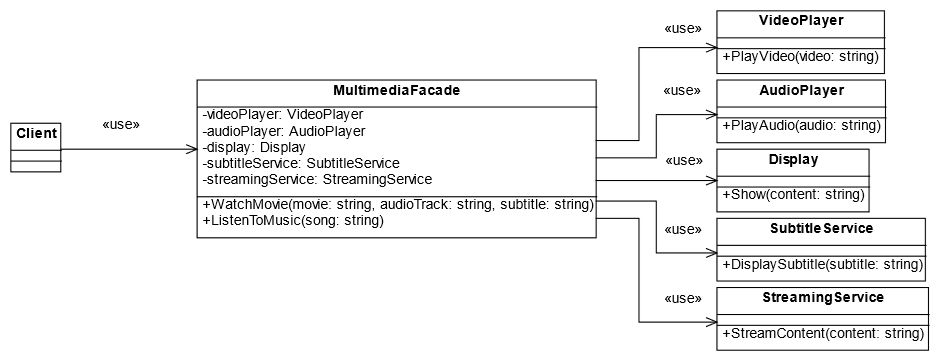What is facade design pattern?
The Facade Design Pattern is a structural design pattern that provides a simplified interface to a set of interfaces in a subsystem (a library, a framework, or any other complex set of classes), making it easier to use. It involves creating a facade class that represents a higher-level, unified interface to a set of interfaces in a subsystem. This pattern hides the complexities of the subsystem and provides a simpler interface for the client code.
A Facade might provide limited functionality compared to directly working with the Subsystem. However, it includes only those features that clients care about.
Having a Facade is handy when integrating our app with a sophisticated library with dozens of features, but we need a tiny bit of its functionality.
How does the Decorator Design Pattern work?
The Facade Design Pattern consists of two main components: the Facade and the Subsystem classes.
The Facade is the main class that clients interact with. It provides a simplified and unified interface to the subsystem. The Facade delegates Client requests to appropriate objects within the Subsystem; the Client typically does not interact with them directly.
Here is a step-by-step explanation of how the Facade Design Pattern works:
1. Subsystem Components:
- Identify a complex subsystem that consists of multiple classes or components.
- These components work together to achieve a certain functionality, but their interactions and dependencies might be intricate.
2. Facade Class:
- Create a Facade class that encapsulates the interactions with the subsystem components.
- The Facade class provides a simplified, high-level interface for clients to interact with the subsystem.
3. Facade-Subsystem Interaction:
- Inside the Facade class, delegate Client requests to the appropriate Subsystem components.
- The Facade coordinates the interactions between the Subsystem components to fulfill the client’s request.
4. Client Interaction:
- Clients interact with the Facade class rather than directly with the Subsystem components.
- Clients are shielded from the complexities of the Subsystem, and they only need to know about and use the Facade’s interface.

Now, let us look at a real-world inspired example: a simplified representation of a multimedia system that includes video playback, audio playback, and a display.

Here is a breakdown of the components:
1. Subsystem Components:
- VideoPlayer: Simulates the functionality of playing a video.
- AudioPlayer: Simulates the functionality of playing audio.
- Display: Simulates the functionality of displaying content.
- SubtitleService: Simulates the display of subtitles.
- StreamingService: Simulates streaming content from a service.
2. Facade Class:
- MultimediaFacade: A facade that provides a simplified interface for higher-level actions such as playing a movie or listening to music. It delegates tasks to the appropriate subsystem components.
3. Client class:
- Represents the client code that interacts with the facade (MultimediaFacade) to perform specific actions.
The example demonstrates two scenarios:
- Watching a Movie: The client uses the MultimediaFacade to play a movie (Inception) and specifies the audio track (DTS).
- Listening to Music: The client uses the MultimediaFacade to play a music track (Stairway to Heaven).
The source code for the presented sample is available on GitHub.
Advantages of the Facade Design Pattern
The Facade Design Pattern offers several advantages in software design and development:
-
Simplified Interface:
The primary benefit of the Facade pattern is providing a simplified and unified interface to a set of interfaces in a Subsystem. Clients can interact with a single, easy-to-use interface provided by the Facade, hiding the complexity of the Subsystem. This simplification makes the system more accessible and reduces the learning curve for developers using the Subsystem.
-
Decoupling:
The Facade promotes loose coupling between the Client code and the Subsystem. Clients are shielded from the details of the subsystem’s implementation. Changes to the Subsystem are less likely to affect the Client code, leading to more maintainable and flexible systems.
-
Encapsulation:
The internal details of the Subsystem are encapsulated within the facade. Clients only need to be aware of the Facade’s interface, which promotes information hiding and encapsulation. This allows for better modularization and separation of concerns.
-
Maintenance and Refactoring:
Changes to the Subsystem can be made without affecting the clients. Since Clients interact with the Facade and not directly with the Subsystem components, modifications to the Subsystem’s internal structure can be made without requiring changes to Client code. This enhances the maintainability of the codebase.
-
Promotes Best Practices:
Facade encourages good design practices like abstraction and modularity. The Facade pattern helps developers adhere to design principles by providing a clear and well-defined interface. It promotes separation of concerns, making the codebase more understandable and maintainable.
-
Reduced Complexity for Clients:
Clients only need to understand and interact with the Facade. The complexity of the Subsystem is hidden behind the Facade, allowing Clients to perform tasks without being burdened by the intricacies of the Subsystem’s components. This results in more readable and manageable Client code.
-
Improved Readability and Usability:
Facade methods are typically named to reflect high-level operations. This naming convention improves the readability of the code and makes it more intuitive for developers to understand and use the provided functionality.
-
Unified Access Point:
The Facade provides a single entry point to the Subsystem. This centralized entry point simplifies the overall system architecture. Clients can interact with the Facade without knowing the details of individual Subsystem components, fostering a cleaner and more modular design.
In summary, the Facade Design Pattern offers advantages such as simplification, decoupling, encapsulation, and improved maintainability, making it a valuable pattern in scenarios where there is a need to hide the complexities of a Subsystem.
Disadvantages of the Facade Design Pattern
While the Facade Design Pattern provides several benefits, it is also important to consider potential disadvantages. Here are some drawbacks associated with the Facade pattern:
-
Limited Flexibility:
The simplified Facade interface may be too rigid for certain clients. Clients using the Facade may have limited control over the functionalities of the Subsystem. If a client needs more fine-grained control over individual Subsystem components, the Facade might not be flexible enough.
-
Implicit Coupling:
Despite promoting loose coupling, the Facade may still introduce implicit coupling. Changes to the Facade or the Subsystem may inadvertently impact Clients. If the Facade becomes tightly coupled with specific Subsystem components, modifications to those components could affect client code.
-
Increased Complexity of the Facade:
As the system evolves, the Facade might become more complex. Over time, additional methods may be added to the Facade to accommodate new features or variations. This can lead to a large Facade class and harder to maintain, potentially defeating the purpose of simplifying the interface.
-
Potential Performance Overhead:
Using a Facade may introduce a performance overhead. Facades often involve additional layers of abstraction. In scenarios where high performance is critical, the added abstraction may introduce some overhead, although the impact is generally minimal.
-
Duplication of Functionality:
The Facade may duplicate some functionalities of the Subsystem. If the Facade needs to expose only a subset of the Subsystem’s capabilities, there may be duplicated logic between the Facade and the Subsystem components. Maintenance challenges can arise if these duplicated functionalities need to be kept in sync.
-
Reduced Visibility of System Complexity:
While the Facade hides complexity, it might also obscure important system details. Developers using the Facade might not have a clear understanding of the internal workings of the subsystem. This lack of visibility can make troubleshooting and debugging more challenging.
-
Not Suitable for Every Use Case:
The Facade pattern may not suit every system. Introducing a Facade might add unnecessary abstraction and complexity in simple systems or scenarios where the Subsystem’s complexity is not a concern.
-
Dependency on the Facade:
Clients become dependent on the Facade. If the Facade becomes a central point of interaction, clients may become tightly coupled to it. This could limit the ability to swap out Subsystem components or make changes to the system without affecting clients.
It is important to carefully consider the trade-offs and assess whether the Facade pattern is appropriate for a given system. The advantages outweigh the disadvantages in some cases, but alternative design patterns or approaches might be more suitable in others.
When should we use the Facade Design Pattern?
The Facade Design Pattern is beneficial in several situations, and it is typically used when we want to provide a simplified and unified interface to a set of interfaces or subsystems. Here are common scenarios where the Facade pattern is particularly useful:
-
Complex Subsystems:
Use the Facade pattern when dealing with a complex Subsystem that consists of multiple classes or components. The Facade pattern simplifies the interaction with a complex system by providing a higher-level interface. It encapsulates the Subsystem’s complexity and hides it behind a facade class.
-
Unified Interface:
Use the Facade pattern to provide a single, easy-to-use interface to a set of interfaces or functionalities. Facade provides a unified entry point, reducing the cognitive load on clients and making the system more user-friendly. It is particularly helpful when working with diverse or intricate Subsystem components.
-
Loose Coupling:
Use the Facade pattern to promote loose coupling between Clients and Subsystem components. By introducing a Facade, clients are decoupled from the details of the Subsystem. This allows for changes to the Subsystem without affecting client code, promoting maintainability and flexibility.
-
Abstraction and Encapsulation:
Use the Facade pattern when we want to adhere to principles of abstraction and encapsulation. The Facade pattern encourages modular design by encapsulating the internal details of the Subsystem. Clients interact with a simplified interface, abstracting away the complexities of the underlying components.
-
Ease of Use:
Use the Facade pattern when we want to improve the ease of use for clients. The simplified interface the Facade provides makes it easier for clients to understand and use the subsystem. It abstracts unnecessary details, leading to more readable and maintainable client code.
-
Integration with Legacy Systems:
Use the Facade pattern with legacy systems or third-party libraries. When working with existing codebases or external libraries, a Facade can serve as a layer of abstraction, adapting the legacy system’s complexities to a more modern and simplified interface.
-
System Maintenance and Refactoring:
Use the Facade pattern to facilitate system maintenance or refactoring. The Facade pattern provides a buffer between the Subsystem and Clients. This allows changes to the Subsystem’s internal structure without impacting clients, making maintenance and refactoring activities more manageable.
-
Client-Specific Interfaces:
Use the Facade pattern to define custom interfaces tailored to Client needs. The Facade can expose only the necessary subset of functionalities required by a particular Client, allowing for a Client-specific view of the Subsystem.
In summary, the Facade Design Pattern is valuable when dealing with complex systems, aiming for a simplified interface, promoting loose coupling, and providing abstraction and encapsulation. It is a good choice when we want to enhance the usability and maintainability of our software.
Real-world examples of Facade Design Pattern
The Facade Design Pattern is commonly used in real-world scenarios to simplify complex systems and provide a unified interface. Here are some real-world examples where the Facade pattern is often applied:
-
jQuery JavaScript Library:
jQuery, a popular JavaScript library, employs the Facade pattern. jQuery simplifies interacting with the Document Object Model (DOM) and handling events in web development. The jQuery library serves as a facade, abstracting away the complexities of cross-browser compatibility and providing a consistent API for developers.
-
.NET Entity Framework:
Entity Framework, a data access technology in the .NET framework, uses the Facade pattern. Entity Framework simplifies database interactions in .NET applications. The DbContext class acts as a Facade, providing a high-level API for querying and updating the database without requiring developers to deal with low-level details.
-
Operating System Interfaces:
Operating systems often use the Facade pattern in their APIs. The operating system provides a simplified interface for complex functionalities such as file systems, network communication, and hardware. Users and applications interact with the operating system through a facade, such as system calls or higher-level APIs, without understanding the underlying system’s intricacies.
-
Graphics Libraries:
Graphics libraries like DirectX or OpenGL use the Facade pattern. These libraries provide a simplified interface for rendering graphics and interacting with GPU hardware. The library serves as a Facade, hiding the low-level details of graphics programming and making it easier for developers to create visually rich applications.
-
Payment Gateways:
Payment gateway APIs often employ the Facade pattern. Payment gateways simplify the process of handling online payments. The gateway API acts as a Facade, abstracting the complexities of payment methods, encryption, and communication with financial institutions.
These examples demonstrate that the Facade Design Pattern is a common and valuable approach in software development, providing a simplified and unified interface for interacting with complex subsystems or libraries.
Conclusion
The Facade Design Pattern is a valuable solution for improving the design and maintainability of software systems, especially in scenarios where there is a need to hide complexity and provide a clean, unified interface for clients.



 (3 votes, average: 3.67 out of 5)
(3 votes, average: 3.67 out of 5)






Belu Daniel
January 17, 2024 at 3:46 am ESTExcellent article! Just one small remark: one of the subtopics is “How does the Decorator Design Pattern work?”. It should be Facade instead of “Decorator”. Thank you